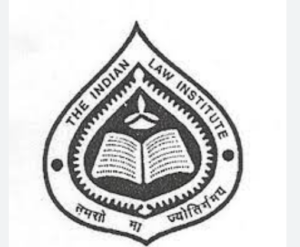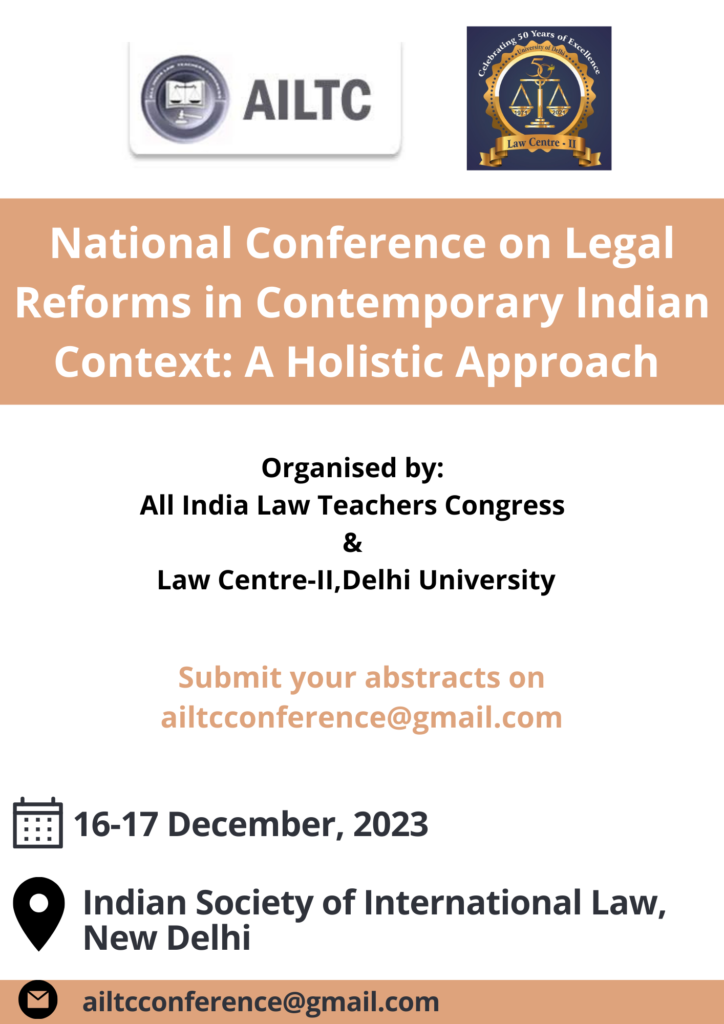Deadline– 31-12-2023
Details of the Organization
The Indian Law Institute is a Deemed University and socio-legal research institute, founded in 1956. Established in New Delhi, primarily with the objective of promoting and conducting legal research, education and training.
Details of the Blog/Paper
The ILILR Journal of the Indian Law Institute is an online, biannual blind peer-reviewed law journal, recognised by UGC- CARE list, under Group- D, S.no. 42, with e-ISSN-0976-1489. Research Papers, articles, book reviews, legislation reviews, case comments etc., are accepted on a rolling basis and there is no deadline as such.
They are an Eco-friendly, open-access student journal. They abide by their publication policies by avoiding the usage of paper as much as possible. They have also made the Journal accessible to everyone from all over the world by simply visiting the official website of The Indian Law Institute.
They engage with authors throughout the review process of the manuscripts to enable a qualitative review without diluting the author’s design. The Journal expects authors to abide by academic integrity and intellectual honesty. Papers submitted for publication should be original. Papers that are already published in other journals, anthologies etc., should not be submitted for publication.
The Indian Law Institute shall be the sole copyright owner of all the published materials. Apart from fair dealing for the purposes of research, private study or critique, no part of the journal shall be copied, adapted, abridged, translated or stored in any retrieval system, computer system, photographic or other system or reproduced in any form by any means whether electronic, mechanical, digital, optical, photographic or otherwise without prior written permission from the Institute.
Topic of paper/Blog
ILILR accepts themes across legal subjects and interdisciplinary matters.
Eligibility
Anyone interested in writing in the above-mentioned topic/theme can write.
Types of Submission and Word Limit
The length of the manuscript should average as follows (all inclusive of footnotes):
- For Article: 6000 to 12000 words
- All Others (Case Comment/Book Review/Bill comment/Legislative comment etc.): 2000 to 6000 words
Submission Guidelines
- All submissions should be sent with a covering letter indicating the Name of The author, Institutional Affiliation, Contact Details and the Topic of the paper.
- They allow a maximum of two authors. Co-authored papers should give details about both authors.
- The Editorial Board will consider the authorship and designation mentioned in the cover letter during submission as final and correct unless otherwise intimated by the author/s. It shall be the responsibility of the Author to intimate the Editorial Board regarding any change in designation during the period in which the paper is being processed. No changes will be entertained after publication
- The Author must send a duly signed and dated copy of Annexure 1, along with the submission.
Screening Process
The ILILR Editorial Team works tirelessly to maintain the standards of the ILILR Journal. Each draft is screened thoroughly in three phases to ensure this:
- An initial Internal Screening is conducted to ensure that the drafts submitted fulfil the general appropriateness of work and that the foundation of the paper is conceptually and theoretically fit. At this stage, the team also makes sure that the draft meets the basic requirements in terms of citation style, formatting, word limits etc.
- The drafts then undergo a Plagiarism Test; the maximum limit of similarity index allowed is 30%. The Authors are requested to make sure that this criteria is fulfilled before submission.
- Subject to the above two tests, the approved drafts are then sent to an expert for Blind Peer Review. The expert evaluates the draft on various parameters, such as the relevancy of the topic, comprehensiveness, original contribution to existing knowledge, language, coherence etc., and the review report is shared with the author.
The whole process takes a minimum of at least 6 to 8 months depending on the influx of submissions. The Authors will be intimated at the end of each stage if modifications are required in the original draft. Final acceptance or rejection is subject to the above 3 tests.
Formatting Guidelines
Manuscripts shall be formatted according to the following guidelines:
- It shall include an abstract of not more than 150 words.
- All citations shall be placed in footnotes.
- Numbers less than 100 shall be spelt out unless they are a percent (e.g., 5 percent).
- Use of the first person shall be avoided.
- All pages shall be numbered.
- A uniform date format shall be used (e.g., August 15, 1947).
- Quotations: Quotations within a sentence must be enclosed in doublequotation marks (“ ”). A quotation within a quotation should be enclosed insingle quotation marks (‘’).
- A quotation longer than three lines should be set out in a separate block indented from both the left and right margins. Do not enclose the quotation in quotation marks. A quotation is introduced with a colon (:), followed by a reference in the footnote.
- When referring to a section or article of a statute in the main text, the word section/’article’ should neither be abbreviated nor capitalized. However, in the footnotes, the section/article should be abbreviated.
E.g. The Constitution of India, art. 30; The Indian Penal Code, s. 42.
Use of Footnotes
ILILR prefers footnotes (to end notes) because of the following reasons:
- To identify the source of quotations or paraphrases;
- To acknowledge indebtedness for words, phrases or ideas borrowed;
- To explain where additional evidence or commentary may be found;
- To provide additional material or discussion that is relevant but which would disrupt the flow of the text if it were included in the main text itself;
- To refer the reader to other parts of the paper; and
- To enable the reader to read the reference without having to turn to the end of the text which would otherwise tend to disrupt the flow of the text and hamper smooth reading.
Citation Format
The Institute has formulated a set pattern of citation (i.e., ILI Rules of Footnoting), which is followed in ILILR and various other publications of the Institute. The citation style in the articles and notes and comments submitted for publication in JILI shall be in conformity with the ILI Rules of Footnoting available at www.ili.ac.in/cstyle.pdf.
Publishing Schedule
The Journal of the Indian Law Institute (JILI) is a quarterly publication. The periodicity is January -March, April-June, July – September, October- December.
Access
The print copies of the Journal of Indian Law Institute are available on an annual subscription basis after payment of the subscription amount. The softcopy is available for free through the ILI Digital Repository.
The link to access is http://14.139.60.116:8080/jspui/handle/123456789/43.








